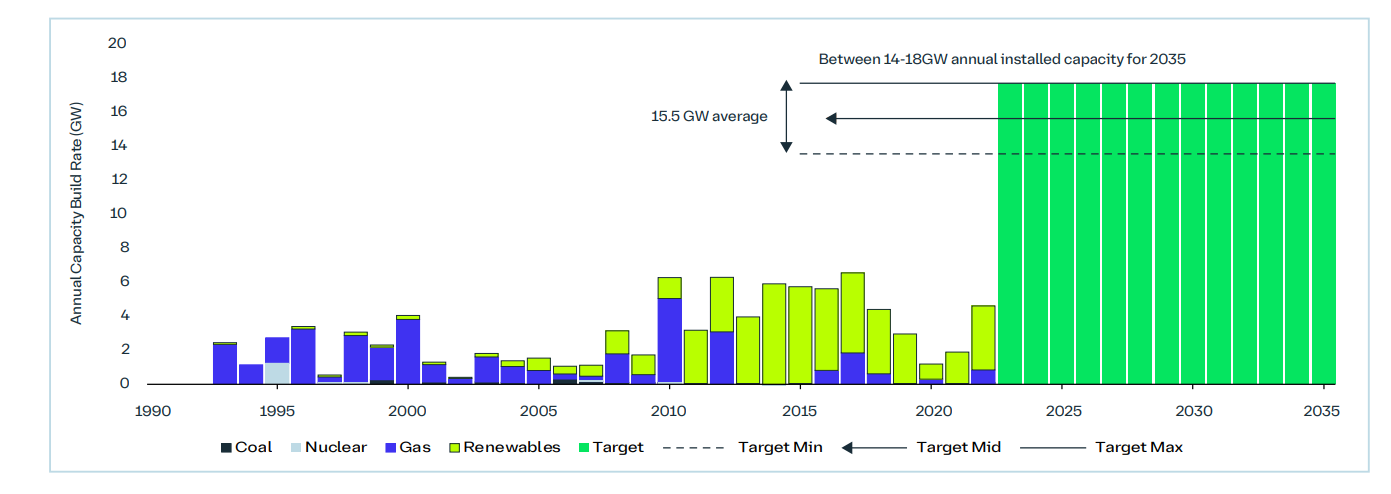Register for free and continue reading
Join our growing army of changemakers and get unlimited access to our premium content

Pictured: Race Bank offshore wind farm. Image: Orsted
The analysis assesses how much new energy generation must come online annually through to 2035 for the UK to meet its headline climate targets. These targets include the carbon budgets set to support the legally binding 2050 net-zero target, plus a newer ambition to bring all unabated fossil-fuel-fired electricity generation out of the mix by 2035.
In 2019, when the UK first set its 2050 net-zero target, AtkinsRealis estimated that it would need to build 10.5GW per year of low-carbon energy generation capacity.
Build-out is needed to replace ageing power plants; displace fossil fuels while maintaining energy security; and account for increased electricity demand from the electrification of sectors such as heating and transportation.
AtkinsRealis’ forecast was increased to 14GW in 2022, as the UK began the process of enshrining the 2035 goal in law.
Now, AtkinsRealis believes that even steeper levels of deployment are needed – an average of 15.5GW per year. This is partly due to slow progress in build-out over the past five years, meaning there is now a shortfall to be accounted for.
For context, the UK has never added more than 6.5GW of new low-carbon capacity in a single year. This record was achieved in 2017.
The new analysis comes with a warning against making up for even larger shortfalls at the last minute in the early 2030s. A rapid build-out of wind and solar within a compact timeframe would lead to heightened challenges including supply chain management, planning and permitting and preparing skilled staff. And the only alternative would be prolonged reliance on unabated gas, jeapordising climate progress.
AtkinsRealis’s market director for net-zero energy Sarah Long summarised: “From reforming the planning system and strengthening energy networks to bolstering the UK’s supply chain, a more gradual increase in new energy capacity is the most likely path to meeting net-zero energy goals over the next decade. However, the scale of the challenge becomes greater each year. We must urgently shift from scenarios into delivery.”
Long welcomed the Government’s recent launch of a roadmap for dramatically scaling the nation’s nuclear generation capacity using a mix of small modular reactors (SMRs) and large-scale projects like Hinkley and Sizewell. Ministers want the UK to host up to 24GW of nuclear generation capacity by 2050, and the roadmap outlines some key milestones to delivery.
Despite strong progress to date, the Climate Change Committee has warned that these plans are not taking shape and being delivered quickly enough. Electricity accounted for 11% of the UK’s emissions in 2022 and credible plans are only in place to deliver around a third of the emissions reductions needed by 2035 according to the Committee.
Global picture
The need for accelerated delivery of clean power is not exclusive to the UK. Other nations supporting the 2035 target include the likes of France and Germany, while more than 90% of GDP is covered by national net-zero targets.
But this is still not rapid enough to align with a global vision of trebling the world’s renewables capacity by 2030. The Agency believes a 2.5-fold increase by 2028 would be possible but only with concerted, urgent changes to policy in virtually every nation.
The Agency also highlighted concerns about the fact that, to date, the scaling of renewables has largely been concentrated in China, the US and Europe. It has been convening policymakers internationally to push for greater support for clean energy in developing and emerging markets.
You can read edie’s full coverage of the IEA’s 2024 renewables report here.



Please login or Register to leave a comment.